A popular trope in horror is the isolated farmhouse, the remote village, where gruesome serial murders take place. Innocent victims stumble onto the site and are brutally tortured and slain.
Shockingly the only thing flawed with this rendition is the setting. The most notorious serial murders have not taken place in remote, out-of-the-way places, but right here among us, in cities and suburbs, often right next door.
No urban settings are home to more serial murders than the Chicago and Milwaukee areas. These adjacent metros have contributed at least 85 killings to the grisly annals of torture-murders. While other killers have racked up more victims, the serial killers of Chicago and Milwaukee are among the most infamous. What’s more, many of the sites where the killers lived, worked and carried out their mayhem still exist. So I decided to take a look around.
Born to Raise Hell
In March of 1966 a vicious 25 year old alcoholic by the name of Richard Speck left his home in Texas after having been arrested 42 times for crimes ranging from forgery and burglary to robbery and assault. He moved to Illinois. In his first two months in his newly adopted home he raped and robbed a 65 year old woman and murdered a 32 year old barmaid. And he was just getting started.
In Chicago Speck stayed with his sister, a former registered nurse, and her husband in their apartment at 3966 N. Avondale Ave. Speck’s brother-in-law attempted to get him employment with the merchant marine, and Speck was waiting for an assignment when he got drunk at the Shipyard Inn at 10063 S. Avenue N. and made his way to a location he had spotted earlier, a dormitory for student nurses at 2319 East 100th Street. Speck broke in and, wielding a knife, systematically raped and murdered eight student nurses. One escaped by hiding under a bed. She was able to give the police a description.
After the slaughter, Speck holed up in a transient hotel on Madison Street where he got drunk and attempted suicide. He was rushed to Cook County Hospital where a resident physician recognized his tattoo after reading about it in the newspaper. The tattoo said, Born to Raise Hell.
Speck was arrested, convicted and sentenced to death, but before he could be executed the death penalty was declared unconstitutional in Illinois, so Speck spent the rest of his life in prison where he died of a heart attack in 1991.
The apartment where he lived and the bar where he got drunk are vacant lots now. But the murder location still exists. The property was listed for sale in 2005 for $66k with nary a word in the listing about its former notoriety.
You would think that once potential buyers discovered what had happened there, they would avoid it like the plague. Anyway, that’s what you would think. But you would be wrong.
The Jolly Joker Clown Club
On a quiet suburban street in Norwood Park Township a handsome two story home stands on the former site of the most notorious serial killings in the United States. On this property, in the crawl space under the former home, twenty-six bodies were unearthed, victims of John Wayne Gacy, the Killer Clown.
Gacy was born in Chicago and by all accounts led a difficult childhood, abused by his father and molested by a family friend. He dropped out of high school and moved to Las Vegas where he worked briefly in a mortuary before returning to Chicago to find his gift. Gacy was an extraordinarily good salesman. Moving to Waterloo, Iowa in 1966, Gacy joined the local Jaycees and became a well-regarded member of the community. With a wife and two children at home, few would suspect that this model citizen also had a penchant for wife swapping, pornography, prostitution and drugs, nor that he had begun molesting the teenage boys on his staff. But when two youngsters accused him of sexual assault, Gacy was arrested and convicted of sodomy.

The modest middle-class neighborhood of Norwood Park with its 50’s era ranch houses was the scene of America’s most notorious serial murders.
He served 18 months of a 10 year sentence and was released on the strength of his sterling record as a model prisoner. Within eight months of his release, Gacy was again charged with molesting a teenage boy, but this time the complaint was dismissed when the accused failed to appear in court. And then, magically, Gacy’s record seemed to vanish.
It’s not hard to imagine that Gacy used his influence as a long standing member of the Jaycees, as well as his talent for persuasion, to pull the strings that led to the burying of his record. In any case, Gacy was able to buy a home in an unincorporated part of Norwood Park, marry for a second time and start a contracting business.
His business thrived. He became a precinct captain and was appointed director of the annual Polish Constitution Day Parade. He joined the Royal Order of the Moose and enrolled in their “Jolly Joker Clown Club” which provided performing clowns for fund raising events. But all was not fun and games.
A Pillar of the Community
When his second marriage fell apart, Gacy was left to live alone in the house at 8213 W. Summerdale. From January of 1972 to December of 1978 Gacy raped, tortured and murdered at least 33 young men and boys between the ages of 14 and 21 in the house. His favorite tactic was to use his reputation as a business owner and pillar of the community to offer his victims jobs, lure them to his house for work and then imprison them and torture them before killing them. Many of the victims were set to work digging “drainage trenches” in the crawl space of his home, unaware that they were digging their own graves.

When Gacy’s crawlspace filled up he took to dumping bodies off the I-55 bridge into the Des Plaines River near Channahon.
Eventually his crawl space filled up with bodies, so Gacy took to dumping his victims off the I-55 bridge into the Des Plaines river near Channahon, Illinois.
His reign of terror came to an end in December of 1978 when Des Plaines police linked Gacy to the disappearance of 15 year old Robert Piest. Gacy’s previous record came to light and investigators secured a warrant to search the home. What they found made international headlines. Gacy was convicted of 33 murders and was executed in 1994. Up until the last, Gacy remained ever the salesman, recanting his confession and trying to convince authorities that they had made a mistake.
The house was razed to the ground in 1979 and the lot sat empty for nearly ten years before a new home was built on the site in 1988. The street address was changed to throw off curiosity seekers.

Ever the salesman, Gacy broke into this affable smile during his mugshot. He had just been arrested for torturing, raping and killing 33 boys.
Many of the other locations related to Gacy are gone or so thoroughly disassociated with the killer clown that they are difficult to find or unrecognizable. But the I-55 bridge over the Des Plaines river remains much as it was in the 1970’s when Gacy stood there, waiting for the oncoming headlights to pass, before dragging the bodies out of his car and dumping them over the railing.
The Devil in the White City
If you look out the window of the Harper Memorial Library at the University of Chicago, you will see the long, narrow stretch of lawn called The Midway Plaisance. In 1893 this was the site of the famous midway at the Chicago World’s Fair, called “The White City”, due to the novel prevalence of electric lights at the time.
In addition to displaying such unique attractions as the elevator and the Ferris wheel, the White City was a hunting ground for a charming, affable pharmacist known as H.H. Holmes, popularized in recent years as the “Devil in the White City”.
Holmes bought a drugstore at the corner of S. Wallace and W. 63rd Street in the Englewood neighborhood of Chicago, two miles from the fair. He killed the woman he bought it from, and then purchased a lot across from the drugstore and built a three-story, block-long hotel. Beneath his hotel he designed a labyrinth of inescapable rooms and blind corridors in which to trap and torture his victims.
By the time Holmes was finished he had murdered at least 27 people, most of them women, although, according to authorities, he was likely responsible for many more, perhaps as many as 200.
Holmes was hanged in 1896 and, like John Wayne Gacy remained calm and amiable right up to the last, another model citizen, tragically misunderstood.
The corner of S. Wallace and W. 63rd Street today looks nothing like it did in 1893. Today a United States Post Office stands on the spot were Holmes’ murder castle once stood. The Midway Plaisance is a calm tree-lined boulevard overlooked by the ivy covered towers of the University of Chicago. You would never know that anything out of the ordinary ever happened here.
Troublesome Odors
On the north side of Chicago in the neighborhood known as Boy’s Town, middle-aged gay men still tell of a boyish looking man from Milwaukee who trolled the bars back in the 80’s looking for pick ups. The stories may be apocryphal. But if Jeffery Dahmer did seek some of his victims in Chicago, he did most of his work 90 miles up the road in his hometown, and what a piece of work it was.
Unlike most other serial killers, Jeffery Dahmer suffered no childhood trauma that could explain his shocking behavior. He was just odd. From an early age, he killed and dismembered animals, a pastime that must’ve troubled him as evidenced by his early resort to the bottle. By the time he graduated high school he was full blown alcoholic. In 1978, at the age of 18, Dahmer picked up a hitchhiker and took him to his father’s house to drink beer with him. When the young man tried to leave, he bludgeoned him to death with a 10 lb. dumbbell. When his father asked him about the foul smell coming from the basement, Dahmer claimed he had dissected a squirrel and dissolved it in chemicals.
His family wanted him to make something of his life, so Dahmer headed off to college. But he wasn’t away long. Flunking out of college and being thrown out of the army for drinking, Dahmer moved back to Milwaukee in 1981 where he moved in with his grandmother in West Allis, a quiet suburban town. While living there he was arrested twice for indecent exposure. He lived with his grandmother until she asked him to leave because of the awful odors coming from his room. It later came to light that he had killed and dismembered at least four people there.
In 1990 Dahmer rented an apartment at the Oxford Apartments at 942 N. 25th Street in Milwaukee. During this time he worked at the Ambrosia Chocolate Factory at 400-499 N. 5th Street. On September 26th 1988 he attempted to drug and molest a 13-year old boy and was arrested and sentenced to five year’s probation. He was required to register as a sex offender. But this didn’t slow him down. He killed four more people before the end of the year.
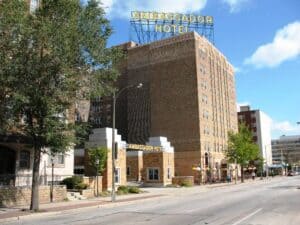
The Ambassador Hotel, mere blocks from Dahmer’s apartment, where he picked up at least one of his victims.
Souvenirs, Zombies and Supper
In May of 1991 a 14-year old boy was found wandering naked, drugged and bleeding from his rectum on the streets of Milwaukee. After a frantic search, Dahmer tracked him down and tried to take him home but was stopped by concerned bystanders who called the police. Dahmer told the cops that the boy was his 19-year old boyfriend and that they had quarreled. The cops let him go. After killing and dismembering the boy, Dahmer kept his skull in the refrigerator as a souvenir.
Thereafter, Dahmer ramped up his slaughter. He killed a victim a week from June through the end of July when he was finally caught. A prospective victim fought off a knife wielding Dahmer after seeing photographs of mangled, dismembered bodies on his bedroom wall. He fled to police who returned with him to the house. While searching for the knife the cops got more than they had bargained for. When they opened the refrigerator, they found the human head. They subsequently discovered three more heads as well as severed hands and penises hidden around the house. They found a frozen human heart in the freezer. Dahmer was arrested.
At the very least Dahmer was a grisly souvenir hunter, more likely he was a necrophiliac and a cannibal. He was fascinated with turning his victims into submissive zombies. He attempted to do so by injecting hydrochloric acid into their brains, leading to an excruciatingly painful death. He regularly dismembered them and sawed them up, sometimes with a chain saw. He may have eaten parts of them for supper.
The most amazing thing is that Dahmer did all this in an apartment building full of tenants. Neighbors reported hearing the roar of the saw and smelling the rank odors.
But whatever complaints were lodged they were not enough to elicit the interest of the police. Dahmer continued his exploits until the evidence of his crimes practically fell into their laps.
The actual building where Dahmer committed his crimes was razed shortly after his arrest. The remaining Oxford Apartments still stood for decades before being demolished. The Ambrosia Chocolate Factory where Dahmer worked has moved, but the building remains across the street from the new bus station in downtown Milwaukee. The Ambassador Hotel at 2308 W. Wisconsin Ave where Dahmer picked up at least one of his victims is still there.
Dahmer was murdered in prison in November of 1994.
The Banality of Evil
The Chicago and Milwaukee murder sites are scattered all over the map. So what is it about Chicago and Milwaukee, situated within 90 miles of each other, that earns them such a dubious honor?
Lest any other American city try to swipe the crown, consider that brevity prevents me from covering two other notorious murderers. William Heirens, the Lipstick Murderer, stabbed three victims in Chicago between 1945 and 1946. His plaintive scrawl in lipstick, Catch me before I kill more, has been used in countless crime dramas. Ed Gein from Plainfield Wisconsin skinned his victims and made masks from their flesh. He is the inspiration for fictional monsters from Hannibal Lechter to Leatherface.
Maybe it’s the severe weather, maybe it’s the centralized locale. Whatever it is, Chicago and Milwaukee taken together are the serial murder capital of the United States.
Yet in looking around at these places I was struck not so much by their creepiness as by how mundane they are. If you are seeking chills and thrills, nothing about these places will get you on the edge of your seat. Rather it’s their sheer ordinariness that begins to tell on you.
These maniacs hid in plain site. They were not the slavering monsters of lore, secreted in some remote castle, but the guy sitting next to you at the bar, the guy introduced to you at a fund raiser, the fellow mowing his lawn next door.
The heinous acts they committed are so shocking and incongruous that it strikes through the ordinary like a flash of lightning in the night, startling you, filling you with dread.
But in the morning everything seems normal again, everyone is just going about their business.
And that’s the creepiest thing of all.
Interactive Map of Serial Murder Sites in Chicago and Milwaukee
Click to Enter Interactive Map
Previous stop on the odyssey: Two Rivers, WI //
Next stop on the odyssey: Grand Rapids, MI
 View the Complete Slide Show: Houses of Horror: The Serial Murder Sites of Chicago and Milwaukee
View the Complete Slide Show: Houses of Horror: The Serial Murder Sites of Chicago and Milwaukee
Other Tour Itineraries on My American Odyssey
John Wayne Gacy Interview Video
Image Credits:
Bloody Knife, TarrynUzumaki; Richard Speck, kbhvac; Speck murder site, Malcolm Logan; Gacy in clown make up, Freeinfosociety.com; Norwood Park, Malcolm Logan; Former site of 8213 W Summerdale, Malcolm Logan; I-55 bridge, Malcolm Logan; Smiling Gacy, Public Domain; H.H. Holmes, Public Domain; Holmes Murder Castle, Chicago Historical Society; S. Wallace and W. 63rd St. today, Malcolm Logan; Dahmer Mug Shot, Mugshots.org; Ambassador Hotel, Malcolm Logan; Oxford Apartments, Malcolm Logan; William Heiren’s scrawl, Criminalprofiler; Ed Gein, Freeinfosociety.com



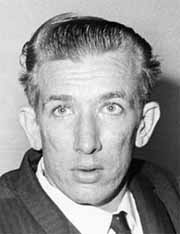



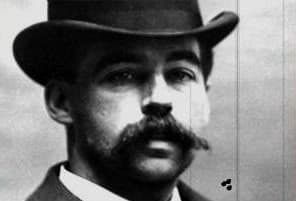



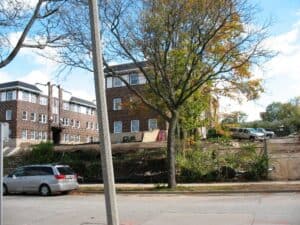
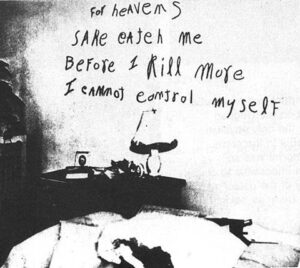

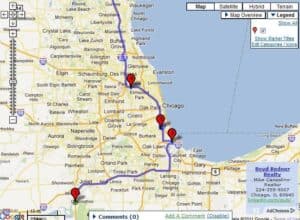
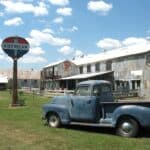





6 comments
[…] Previous stop on the odyssey: Acadiana, LA // Next stop on the odyssey: Chicago/Milwaukee […]
[…] stop on the odyssey: Chicago-Milwaukee // Next stop on the odyssey: New York, […]
[…] Houses of Horror: The Serial Murder Sites of Chicago and Milwaukee […]
[…] Houses of Horror: The Serial Murder Sites of Chicago and Milwaukee […]
[…] Went Down to the Crossroads: A Blues Tour of the Delta […]
[…] Houses of Horror: The Serial Murder Sites of Chicago and Milwaukee […]